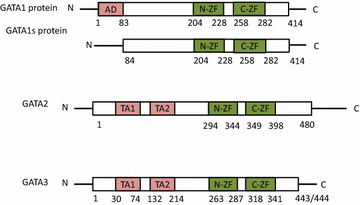GATA family transcriptional factors: emerging suspects in hematologic disorders
- PMID: 26445707
- PMCID: PMC4594744
- DOI: 10.1186/s40164-015-0024-z
GATA family transcriptional factors: emerging suspects in hematologic disorders
Abstract
GATA transcription factors are zinc finger DNA binding proteins that regulate transcription during development and cell differentiation. The three important GATA transcription factors GATA1, GATA2 and GATA3 play essential roles in the development and maintenance of hematopoietic systems. GATA1 is required for the erythroid and megakaryocytic commitment during hematopoiesis. GATA2 is crucial for the proliferation and survival of early hematopoietic cells, and is also involved in lineage specific transcriptional regulation as the dynamic partner of GATA1. GATA3 plays an essential role in T lymphoid cell development and immune regulation. As a result, mutations in genes encoding the GATA transcription factors or alteration in the protein expression level or their function have been linked to a variety of human hematologic disorders. In this review, we summarized the current knowledge regarding the disrupted biologic function of GATA in various hematologic disorders.
Keywords: GATA; Hematologic disorder; Transcription factor.
Figures

Similar articles
-
The role of GATA family transcriptional factors in haematological malignancies: A review.Medicine (Baltimore). 2024 Mar 22;103(12):e37487. doi: 10.1097/MD.0000000000037487. Medicine (Baltimore). 2024. Retraction in: Medicine (Baltimore). 2024 May 3;103(18):e38232. doi: 10.1097/MD.0000000000038232. PMID: 38518015 Free PMC article. Retracted. Review.
-
GATA-related hematologic disorders.Exp Hematol. 2016 Aug;44(8):696-705. doi: 10.1016/j.exphem.2016.05.010. Epub 2016 May 25. Exp Hematol. 2016. PMID: 27235756 Review.
-
[Genetic control of hematopoiesis].C R Seances Soc Biol Fil. 1997;191(1):105-11. C R Seances Soc Biol Fil. 1997. PMID: 9181132 Review. French.
-
GATA factor switching during erythroid differentiation.Curr Opin Hematol. 2010 May;17(3):163-8. doi: 10.1097/MOH.0b013e32833800b8. Curr Opin Hematol. 2010. PMID: 20216212 Review.
-
Characterization of hematopoietic GATA transcription factor expression in mouse and human dendritic cells.Blood Cells Mol Dis. 2015 Dec;55(4):293-303. doi: 10.1016/j.bcmd.2015.07.006. Epub 2015 Jul 14. Blood Cells Mol Dis. 2015. PMID: 26460250
Cited by
-
Epigenetic regulation of cellular and cytomegalovirus genes during myeloid cell development.Intern Med Rev (Wash D C). 2017 Mar;3(3):10.18103/imr.v3i3.385. doi: 10.18103/imr.v3i3.385. Intern Med Rev (Wash D C). 2017. PMID: 28707002 Free PMC article.
-
Nuclear features of infiltrating urothelial carcinoma are distinguished from low-grade noninvasive papillary urothelial carcinoma by image analysis.Oncol Lett. 2017 Sep;14(3):2715-2722. doi: 10.3892/ol.2017.6474. Epub 2017 Jun 23. Oncol Lett. 2017. PMID: 28928814 Free PMC article.
-
Hematopoietic Stem Cell Factors: Their Functional Role in Self-Renewal and Clinical Aspects.Front Cell Dev Biol. 2022 Mar 24;10:664261. doi: 10.3389/fcell.2022.664261. eCollection 2022. Front Cell Dev Biol. 2022. PMID: 35399522 Free PMC article. Review.
-
GATA2 Deficiency and Epstein-Barr Virus Disease.Front Immunol. 2017 Dec 22;8:1869. doi: 10.3389/fimmu.2017.01869. eCollection 2017. Front Immunol. 2017. PMID: 29375553 Free PMC article. Review.
-
A population of hematopoietic stem cells derives from GATA4-expressing progenitors located in the placenta and lateral mesoderm of mice.Haematologica. 2017 Apr;102(4):647-655. doi: 10.3324/haematol.2016.155812. Epub 2017 Jan 5. Haematologica. 2017. PMID: 28057738 Free PMC article.
References
Publication types
LinkOut - more resources
Full Text Sources
Other Literature Sources
Research Materials

